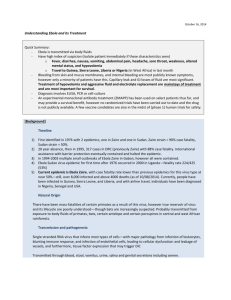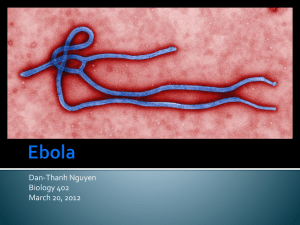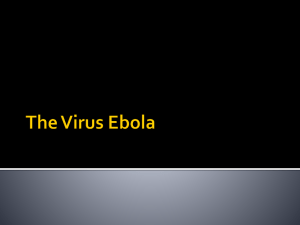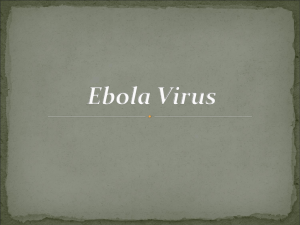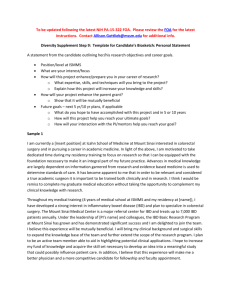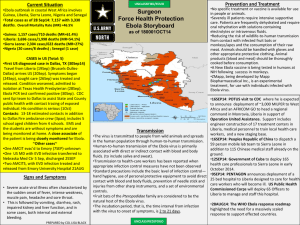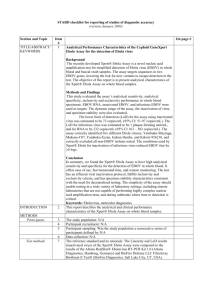The Ebola Virus
advertisement
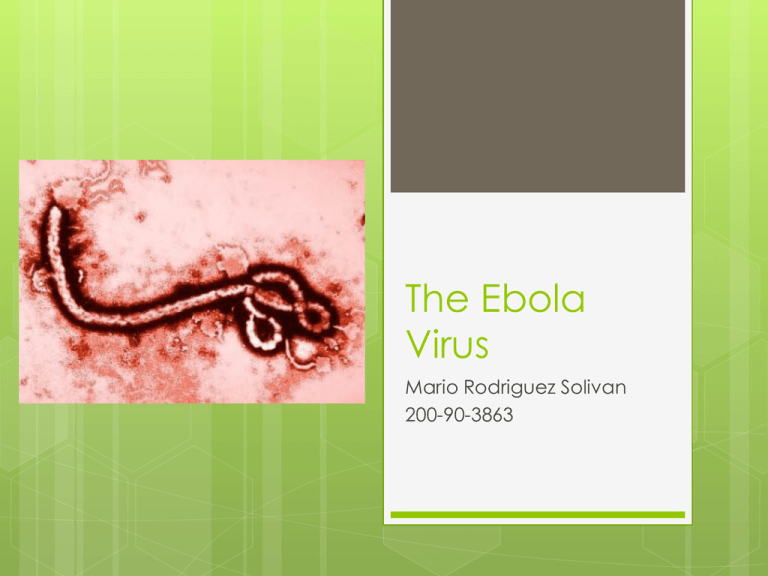
The Ebola Virus Mario Rodriguez Solivan 200-90-3863 What is Ebola? First discovered in 1976 Severe often fatal viral disease Human and non-human primates Lytic life cycle Does not integrate in host genome Causes viral hemorrhagic fever With an incubation period of 2 to 21 days Internal bleeding Taxonomy Group: Group V Order: Mononegavirales Monos = single(strand) Negare = negative ssRNA (-) Family: Filoviridae Genus: Ebolavirus Species: Zaire, Reston, Ivory Coast, Sudan, Bundibugyo Morphology Pleomorphic Filamentous 800-14,000 nm in length 80-100 nm diameter 970nm smallest found that can cause infection Genes 7 main segments app. 19kb NP: structural nucleoprotein N terminal interacts with the RNA to contact the rest of the proteins in matrix and envelope VP35: plays a strong roll in mRNA synthesis and replication of the negative strands VP40: MAIN TARGET for research as of 2012 Bridges the lipid envelope with the nucleocapsid Mutations or removal of the protein have shown to attenuate the virus Genes GP/SGP: glycoprotein and secreted glycoprotein Non-structural can confound the immune system VP30: important for budding out of membrane VP24: Inhibits INF-alpha/beta and INF-gamma signaling L: L-RNA polymerase Copies the negative strand to make the positive transcripts Gene Map Origin New serological studies Fruit bats (Pteropodidae) Contain specific antibodies to Ebola Probable Natural reservoir Chimpanzee, Gorillas, smaller primates Carriers of the virus Some strains and species will affect them Ecological Cycle Different Species Zaire Congo region of Africa (Zaire) Most lethal of all species Sudan Region of Sudan and Uganda High mortality rate Up to 90% mortality rate App. 53% Bundibugyo Bundibugyo District of Uganda Province Orientale Democratic Republic of Congo 2007 – 2012 App. 36.3% moratality rate Different Species Reston Named after Reston, Virginia First Discovered in crab-eating macaques Mutation from other Ebola Virus Mostly non-pathogenic towards humans Philippines caused human infection Less aggressive than African Ebola Extremely hazardous to monkeys Different Species Côte d'Ivoire AKA Taï Forest and Ivory Coast First found in Taï Forest of the Côte d'Ivoire in Africa Highly infectuous to chimpanzees Swiss ethologist infected during necropsy on the chimps “Dengue-like” symptoms a week later Transported to Switzerland for treatment 2 weeks later she was released from hospital Did not fully recover for 6 weeks after release Viral Life Cycle Virion entrance 1. Endocytosis Formation of endosome Endosome binds with lysosome 2. 3. Formation of endolysosome Acidification of endolysosome 4. Release genetic material Replication of ssRNA(-) 5. Form (+) strand Transcription of newly formed ssRNA(+) 6. Assisted by VP30, VP35 and L protein Translation 7. mRNA encoding for GP Travel to ER 8. Where GP is synthesized GP is further modified in Golgi 9. Delivered to plasma membrane in secretory vesicles All viral proteins now assemble with the membrane associated proteins 10. Virions bud from cell surface GP is also secreted Pathogenesis Hemorrhagic fever Multisystem syndrome Damaged vascular system Internal bleeding Body regulations abnormal Mode of Attack Endothelial cells Walls of vascular system Cytokines Inflammation Hepatic Cells Swelling Cytokines TNF-alpha, IL-6, IL-8 Hemorrhages all over Symptoms First signs Headache Fever Joint and muscle aches Weakness Vomiting Diarrhea Fatigue Advanced signs Internal bleeding Orificial bleeding Cutaneous ruptures Hepatic inflamation Cytokines Renal disfunction Diagnostics Virus isolation Reverse transcriptionPCR Monoclonal antibodies that bind to NP Determine the species Antigen-capture ELISA Primers designed specifically for NP region Real-time quantitative RT-PCR Green Dye Primer set used to amplify the L-protein genes Monoclonal antibodies NP, VP40, GP Immunizing mice with rNP React with epitopes in carboxyl groups at NP terminals AWESOME FACT! The rNP of the Reston EBOV could only detect Reston NP… but the Zaire rNP could detect NP from all 5 species! Prevention NO VACCINES AVAILABLE Avoid traveling to areas of known outbreaks Wash your hands frequently Check CDC before traveling Wild animal meat in developing countries markets Avoid contact with infected people Body fluids, exposed tissues, blood, semen Follow infection-control procedures Like any other infectious disease Avoid bush meat Gloves, masks, eye shields, careful disinfections Don't handle remains Dead bodies are still contagious TIM-1 T-cell immunoglobulin and mucin domain 1 This human protein binds to the EBOV GP Recent Study Reduction of this receptor reduces infection ARD5 Monoclonal Antibody Blocked EBOV binding and infection Anti-TIM-1 New antiviral approach Statistics 1976-2012 2014 http://www.euronew s.com/2014/04/12/w est-africa-doctorsfight-to-containebola-outbreak/ https://www.youtube .com/watch?v=5BRJ PCsUM2w Questions What kind of genetic material does Ebola have? A. dsRNA+ B. ssDNA C. ssRNA D. dsDNA E. ssRNA+ What GROUP does EBOV belong to? A. V B. III C. I D. II E. IV In what organelle is GP (glycoprotein) synthesized? A. Mitochondria B. Nucleus C. Golgi D. ER E. Lysosome Why is it suspected that the fruit bat is the natural reservoir for EBOV?... ANSWER OUT LOUD Citations http://jvi.asm.org/content/77/3/1793 http://www.cell.com/cell/abstract/S0092-8674(13)00886-6 http://en.wikibooks.org/wiki/Structural_Biochemistry/Glyco proteins/Ebola_Virus http://www.ncbi.nlm.nih.gov/pmc/articles/PMC3485981/ http://edusanjalbiochemist.blogspot.com/2014/04/thedeadly-ebola-virus-frequently-asked.html http://www.ncbi.nlm.nih.gov/pmc/articles/PMC3100998/fi gure/fig01/ http://www.iflscience.com/health-and-medicine/newantiviral-shows-potential-against-ebola http://www.cdc.gov/vhf/ebola/outbreaks/guinea/ http://wwwnc.cdc.gov/travel/notices/alert/ebola-guinea http://www.elmundo.es/salud/2014/04/16/534d2762ca474 14d4e8b456d.html?cid=SMBOSO25301&s_kw=twitter http://www.who.int/csr/don/2014_04_ebola/en/ http://www.virology.ws/2012/01/18/how-lethal-isebolavirus/ http://wwwnc.cdc.gov/eid/article/3/1/97-0107_article.htm https://www.google.com.pr/search?q=province+orientale +&oq=province+orientale+&aqs=chrome..69i57j0l5.5777j0j7 &sourceid=chrome&essm=93&ie=UTF-8 http://www.microbiologytext.com/index.php?module=Bo ok&func=displayarticle&art_id=494 http://www.ncbi.nlm.nih.gov/pubmed/24283270 http://www.microbiologytext.com/index.php?module=Bo ok&func=displayarticle&art_id=494 http://www.infectioncontroltoday.com/news/2014/05/ebo la-virus-disease-in-west-africa-226-cases-149-deaths.aspx http://www.stanford.edu/group/virus/filo/eboci.html http://www.ncbi.nlm.nih.gov/pmc/articles/PMC1459631/ http://www.pnas.org/content/108/20/8426 http://www.euronews.com/2014/04/12/west-africadoctors-fight-to-contain-ebola-outbreak/



